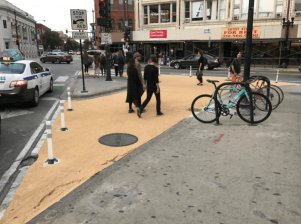Indianapolis Paves the Way for Bikes and Pedestrians

Construction is underway on what may be the nation’s most advanced urban greenway system.
Indianapolis, Indiana is making what could be the boldest step of any North American city towards supporting bicyclists and pedestrians. Known as an extremely auto-oriented city, most closely associated with the Indianapolis 500, this is one of the last cities we would have expected to see systematically removing vehicle lanes and replacing them with bicycle and pedestrian space.
The Indianapolis Cultural Trail is a bold vision for about 8 miles of separated greenway that is currently being built through the downtown core of Indianapolis. Led by the Central Indiana Community Foundation in partnership with the city, the project is a visionary response to skyrocketing obesity and the opportunity to leverage and better serve downtown infrastructure investments.

Downtown Indianapolis before the Cultural Trail.

Downtown Indianapolis after the Cultural Trail.
More than just a separated bike path, the Cultural Trail is an economic development tool that will help support and connect the city’s many cultural and civic destinations. It will help revitalize streets by bringing more people downtown and increasing the circulation and length of time that people spend in the central city. As it becomes part of the city, it will also enhance the public presence of existing destinations and help create many new destinations throughout the downtown.

The Trail will help connect and define several districts within the downtown core.
A combination of private and federal funds are being used to pay for the project. Public spaces have generally not attracted this kind of private investment, particularly in car-dominated Midwestern cities, but a bold vision and strong leadership at the community foundation has raised the bar for other cities.

The design of the path will variably integrate and separate pedestrians and bicylists.
Project for Public Spaces was in Indianapolis last week doing Placemaking training for the grantees and partners of the community foundation’s Inspiring Places Initiative. We are part of the design team for the Cultural Trail project, doing the international best practices research of separated bike paths that informed the final design. Andy Wiley-Schwartz, who now works as an Assistant Commissioner at the New York City Department of Transportation, worked on the project while at PPS.

Sidewalk extensions make pedestrians and bicyclists more prominent on car-dominated streets.
One of the challenges in the design was to figure how to deal with intersections. While we found many different approaches from around the world and discussed additional options, we decided that reducing the crossing distance for bikes and pedestrians by extending the curbs and creating large integrated pedestrian areas would work best.
The Cultural Trail is creating a powerful impetus for Indianapolis neighborhood groups to begin redefining their streets as public spaces that satisfy a broad range of community needs. Indianapolis — a quintessential Midwestern car town — has decided that a street can and should be more than just a place to drive and store motor vehicles.
